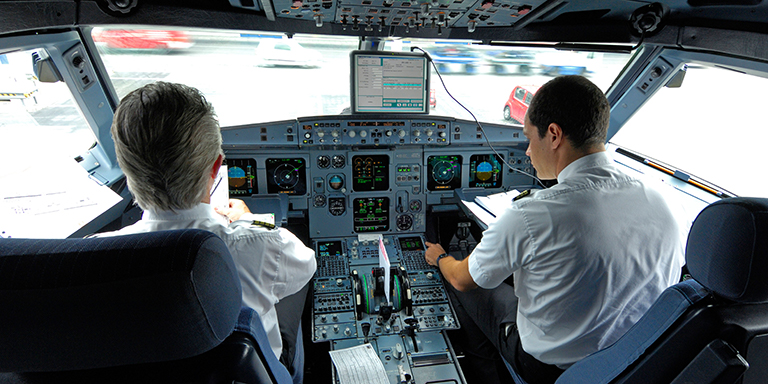5 sales tips from … the cockpit
InsightsArticle16 October 2019
To improve your sales effectiveness, do what commercial airline pilots do – Try incorporating this sales advice from Bart Shachnow, Sales Performance Director
OK, I think I have your attention. This article’s headline was designed to grab you because what commercial airline pilots do has absolutely nothing to do with selling.
Or does it?
My good friend, Marty, is a veteran airline pilot. He’s also a captain, which means he is in charge of his airplane and everything that happens inside that plane before, during and after it takes off and lands, right until he hands over authority to the next crew. Since I’ve always been fascinated by flying, I’ve asked him a lot of questions about what he does and how he does it. Those conversations have convinced me there’s a lot about his job that applies directly to selling effectively.
I have always believed we can gain important insights and perspectives from unexpected sources. So bear with me (maybe even humour me a little) and consider how Marty’s work routine might help you improve your selling technique.
Dress code: Everyone is familiar with a flight crew’s uniforms. Typically, you’ll see a pilot in a suit, tie and matching hat, which is reminiscent of military-style attire. Grooming is typically conservative as well. Many airlines do not allow beards or unconventional hairstyles. You will see the same style of dress in pre-flight safety videos, in which pilots often appear. The attire is deliberate and designed to convey that the people in charge are button-downed, highly trained and disciplined. This helps convey trust and peace of mind among the flying public.
Of course, this style runs counter to general sartorial trends that lean toward informality and self-expression, increasingly even in conservative industries such as finance and insurance. Use your own judgment in terms of how you dress. But in a business like insurance – which, similar to flying, requires that we engender a high level of confidence, trust and comfort level in our customers – a conservative style of dress can be helpful in conveying a positive image of our work.
Preparation and planning: Every flight Marty commands starts with a thorough evaluation of multiple critical pieces of information, including the route, weather, flight plan, assigned altitudes, fuel needs, expected turbulence along the planned route and aircraft maintenance status. What’s more, every major event in the flight requires the review and completion of a checklist. There are checklists for ensuring that all cockpit switches, dials and levers are properly engaged and functional; checklists for backing the plane out of the gate; checklists for take-off, and checklists for landing. No items on the checklist can be skipped (although there is some discretion for overriding a deficient item for substantially good reason).
How many sales calls do we make that are haphazard, ill-planned or organized at the last minute? In planning and preparing for your sales calls, do you have a checklist that covers all the critical touch points with the prospect or customer you are meeting?
Situational awareness: There are certain aspects of flying an airplane that require intense concentration and focus on multiple factors occurring simultaneously. For example, during takeoff, Marty has to be aware of the plane’s status, such as cargo doors that might have come ajar, the stabilizer trim, the plane’s weight and speed, and what he needs to do if he is suddenly confronted with a fire, engine failure, wind shear and/or dangerous objects on or near the runway. If so confronted, his decision must be made in seconds and will have to be correct or the consequences could be disastrous.
In selling, we’re not in similarly fraught life-or-death situations. But salespeople must also be situationally aware of multiple events that could be problematic, and respond swiftly and appropriately. We have to be mindful of both verbal and nonverbal cues that a prospect or customer may be sending that provide critical information about his/her needs, insurability, level of interest in our products and services, etc.
Ongoing skill development: All commercial airline pilots are on a recurrent training cycle to keep them sharp and up to date on the latest techniques and strategies for flying the plane safely and managing or mitigating risks. You’ve probably seen pilots’ training simulators. Marty tells me the latest simulators are even more expensive than the planes he flies. The simulators create situations and potential disasters that are, practically speaking, far more extreme than he is ever likely to encounter in reality. But that training is designed to give him the skills, composure and confidence he will need should he ever face a complex, high-risk situation. Consider Capt. Chesley “Sully” Sullenberger’s miracle landing on the Hudson River. All commercial airline pilots train for that kind of possibility.
As salespeople, we need to train ourselves to confront situations that are difficult and highly challenging. That could include questions, complaints and/or objections expressed by prospects and customers. Are you taking the steps you need to anticipate, plan and prepare for uncomfortable situations like these? Have you practiced them with someone who has the background, experience and skill set to really challenge you? In other words, do you put yourself through a “flight simulator” that will give you the skills, composure and confidence you will need in a challenging sales situation? The time to practice for high-risk sales contingencies is not when you’re in front of the actual prospect or customer.
Post-event facilitated debrief: Imagine you’re flying somewhere for business or pleasure. Your plane takes off on time, the flight is smooth, the service is great, you arrive early at your destination … everything is perfect, right? There’s nothing else to ask for. How can you improve on perfection?
To a commercial airline pilot, there’s always room for improvement, and Marty’s airline requires that the captain and second-in-command (aka first officer) engage in what is known as a facilitated debrief after every flight (emphasis on every, as in no exceptions). The debrief covers all aspects of their teamwork to get the airplane safely from its origin to its destination, and is a written document and permanent record of the flight. Both parties, regardless of rank, are required to provide an honest evaluation of the other, even where there is a significant difference in age and experience. I asked Marty what he might be able to learn from a first officer. “Are you kidding?” he said. “I’ve had first officers who are still in their 20s who have landed fighter jets at night on aircraft carriers that were bobbing and weaving in the middle of the ocean. You don’t think I can learn something about flying from someone like that? Both our ongoing simulator training and facilitated debriefs are designed to not only help us get better, but to reinforce that there’s always something new we can learn to improve our skills.”
Too many in our industry believe that, once they have attained a certain age or level of experience, there’s nothing more to learn. That mindset has even been legally codified: 16 state insurance departments provide waivers or reduced continuing education requirements for licensed agents and brokers who have reached a certain age or have been licensed for a certain amount of time (as little as 10 years).
If there’s anything we can all agree on, it’s that the world is constantly changing and such change impacts how we manage risks. Many older, more experienced agents and brokers understand they need to learn from those in the industry who are much younger. Millennials, Gen Xers and even Gen Zers (the oldest of whom are now 24 years old) are starting and running businesses and doing so in ways that boomers like myself may not fully recognize or understand. If we’re going to help them be successful, either as brokers or as business owners, we have to encourage and solicit their feedback as to how they see the world and what they need from us to be more successful. Which reminds me of the observation of the author Robert Heinlein, who said, “When one teaches, two learn.”
So, there you have it: Pilots are not salespeople, but they employ successful strategies in their normal routine that may have application to your sales approach. Be open-minded and consider how these techniques might apply:
- Dress code: Your style of dress can help convey confidence and trustworthiness – or, if you’re not careful, the opposite.
- Preparation and planning: Make sure to plan your sales calls to achieve your objectives. Consider using a checklist to confirm all aspects of the sales call are adequately addressed.
- Situational awareness: Information you glean from a prospect or customer is not the only relevant data to be considered. Be aware of your surroundings and not only what the prospect or customer says, but what they don’t say with verbal and nonverbal cues.
- Ongoing skills development: Commit yourself to ongoing, continuous improvement. Our industry is always changing. Unless you are changing and adapting, you’re selling yourself (and your customers) short.
- Post-event facilitated debrief: Every sales call, whether it went well or badly, is a learning opportunity. Ask for feedback from colleague(s) who accompanied you and/or even from the prospect or customer.
Read more from Bart Shachnow



